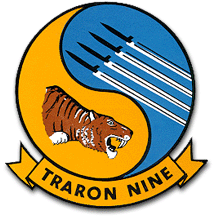
The McDonnell DouglasT-45 Goshawk is a highly modified version of the British BAE Systems Hawk land-based training jet aircraft. Manufactured by McDonnell Douglas and British Aerospace, the T-45 is used by the United States Navy as an aircraft carrier-capable trainer.

Aviation safety is the study and practice of managing risks in aviation. This includes preventing aviation accidents and incidents through research, educating air travel personnel, passengers and the general public, as well as the design of aircraft and aviation infrastructure. The aviation industry is subject to significant regulation and oversight.

A naval aviator is a commissioned officer or warrant officer qualified as a crewed aircraft pilot in the United States Navy or United States Marine Corps. United States Coast Guard crewed aircraft pilots are officially designated as "Coast Guard aviators", although they complete the same undergraduate flight training as Navy and Marine Corps crewed aircraft pilots, and are awarded the same aviation breast insignia.

In aviation, a water landing is, in the broadest sense, an aircraft landing on a body of water. Seaplanes, such as floatplanes and flying boats, land on water as a normal operation. Ditching is a controlled emergency landing on the water surface in an aircraft not designed for the purpose, a very rare occurrence. Controlled flight into the surface and uncontrolled flight ending in a body of water are generally not considered water landings or ditching.

In an internal combustion engine, fuel starvation is the failure of the fuel system to supply sufficient fuel to allow the engine to run properly, for example due to blockage, vapor lock, contamination by water, malfunction of the fuel pump or incorrect operation, leading to loss of power or engine stoppage. There is still fuel in the tank(s), but it is unable to get to the engine(s) in sufficient quantity. By contrast, fuel exhaustion is an occurrence in which the vehicle in question becomes completely devoid of usable fuel, with results similar to those of fuel starvation.

The VT-9 Tigers is one of four U.S. Navy strike jet training squadrons and one of two based at Naval Air Station Meridian in Mississippi.

Training Squadron EIGHT SIX (VT-86), also known as the "Sabrehawks," is a United States Navy advanced jet training squadron based at the Naval Air Station Pensacola, Florida. Training Squadron 86 is a tenant command of Training Air Wing 6. They are a training squadron flying the T-45C Goshawk. Their tailcode is F and their radio callsign is ROKT.

Naval Air Station Kingsville or NAS Kingsville (NASK) is a United States Navy Naval Air Station located approximately 3 miles east of Kingsville, Texas in Kleberg County. NAS Kingsville is under the jurisdiction of Navy Region Southeast and is the headquarters of Training Air Wing Two. The station also operates a nearby satellite airfield, NALF Orange Grove.

The Naval Air Training Command (NATRACOM) is a one-star Echelon III command that conducts flight training of student Naval Aviators, and Naval Flight Officers. Though it does not conduct Naval Aircrew training which is conducted by Naval Education and Training Command's Naval Aviation Schools Command (NASC), it is responsible for monitoring the production of Aircrewmen through the Naval Aviator Production Process (NAPP). Through the NAPP, NATRACOM is also responsible for programming and monitoring the production of all Navy and Marine Corps Fleet Replacement Squadrons.

Airborne Tactical Advantage Company (ATAC), is a government contractor based in Newport News, Virginia, United States. It operates Dassault Mirage F1, Mk-58 Hawker Hunter, Israeli F-21 Kfir, Douglas A-4 Skyhawk, and Aero L-39 Albatros military aircraft in tactical flight training roles for the United States Navy, United States Air Force, and Air National Guard.

Training Air Wing TWO is a United States Navy aircraft training air wing based aboard Naval Air Station Kingsville, in Kingsville, Texas. TW-2 is one of five training air wings in the Naval Air Training Command, and consists of two jet training squadrons. The wing trains Student Naval Aviators from the U.S. Navy, U.S. Marine Corps, and international allies. Following completion of primary flight training and selection of an advanced training pipeline, Student Naval Aviators are assigned to TW-2 for either intermediate and advanced strike pipeline training or advanced E-2/C-2 training in the T-45C Goshawk jet training aircraft.

Training Squadron 21 (VT-21), known as the Redhawks, is a U.S. Navy strike jet training squadron stationed aboard Naval Air Station Kingsville, Texas flying the T-45C Goshawk. The Redhawks are one of four strike jet training squadrons in operation today, and are under the command of Training Air Wing Two.

Training Air Wing ONE is a United States Navy aircraft training air wing based aboard Naval Air Station Meridian, located 11 miles northeast of Meridian, Mississippi in Lauderdale County and Kemper County. TW-1 is one of five training air wings in the Naval Air Training Command, and consists of two jet training squadrons. The wing trains Student Naval Aviators from the U.S. Navy, U.S. Marine Corps, and international allies. Following completion of primary flight training and selection of an advanced training pipeline, Student Naval Aviators are assigned to TW-1 for either intermediate and advanced strike pipeline training or advanced E-2/C-2 training in the T-45C Goshawk jet training aircraft.
This page is based on this
Wikipedia article Text is available under the
CC BY-SA 4.0 license; additional terms may apply.
Images, videos and audio are available under their respective licenses.













